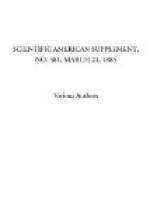1. Elementary Section, First Year.—The pupil must manufacture all the small tools necessary for making unfinished movements; that is, drills, reamers, punches, files, etc. He must then learn to file and turn, and to make use of the finishing lathe with the bow, or of the foot lathe.
In general, the time taken by an apprentice to manufacture his tools is from two to three months, and he can scarcely go to work on the movements before this.
In this class the regular pupils have to execute seven pieces of work in the rough, two for horizontal escapements with key and regulating wheel, and five for various other escapements. Among these there is one for simple repetition and one for minute piece. Aside from the work fixed by the programme, the pupils may manufacture all the other complicated pieces upon obtaining the authority for it from their masters and the director.
The average time employed in performing the work imposed by the programme necessarily depends upon the capacity of the pupil, but we may say that in general ten months are necessary.
Second Year.—After executing his last piece of work in a satisfactory manner, the apprentice passes into the class in regulators, where he begins to manufacture the small tools that he will require.
In this work, as in the preceding, he must take all his pieces from the crude metal, and he must do the forging himself, as well as the roughing down, the turning, filing, and shaping, and finally the finishing, without the aid of any other machine than the dividing one.
In general, after eighteen months of work, the apprentice goes to the finishing shop, where the delicate and minute work begins, pivoting, putting the wheels in place, and practical study of gearings. After learning how to divide a wheel correctly, he is set to work on pinions and wheels in the rough, which he must rivet, finish, and pivot according to the different planes of the pieces that have been calculated and executed by him under the direction of the master.
The programme to be followed by the pupils of the class in finishing is, as regards number of pieces, the same as that of the preceding classes, that is to say, seven.
In general, the pupil passes from the class in finishing to the class in dial-trains, where he makes two of these for his pieces—one a simple and the other a minute train. The teaching of this part is very important as regards the manufacture of escapements. In constructing the dial train, the pupil perfects his filing and learns to make the adjustments correct.
The last class in the elementary instruction is the one in escapements (Fig. 1), the programme of which includes several distinct parts: (1) The tools that are strictly necessary; (2) escapement and cylinder adjustment; (3) making the compensating balances for the pupil’s pieces; (4) pivoting, putting in place, and finishing the escapements in regulating pieces. Here, as in the preceding classes, the pupils must do all the work themselves. During their stay in the elementary classes the work done is submitted to the director, who examines it and sends it back to the instructors accompanied with a bulletin containing his estimate as to its value, and his observations if there is occasion to make any.




